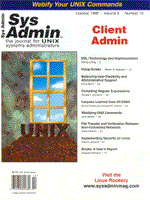
syslog
Some might say that client administration, aka client management, is what life is all about. You manage to have your client call you, instead of your competitor, whenever they need your type of services. You also manage to have them call you far enough in advance that their deadline for the project is actually reasonable. And, finally, you manage to make a profit on your efforts, even while giving them a good deal. For SAs, however, the client administration picture differs. Client administration is all about what's at the other end of the server -- whether it's a UNIX workstation, an X-Term, or a desktop PC. In addition to such traditional clients, today's systems administrator must also consider services for more esoteric clients, such as palmtop computers and other hand-held devices (e.g., PalmPilots and other PDAs). Each type of client brings with it a different set of server considerations, and may require special handling to configure the appropriate services environment for the client. X-Terms and UNIX workstations are traditional clients of UNIX servers, and the client administration elements they require are straightforward. The right combination of X servers, network connectivity, NFS-based storage, and peripheral access provided via local or remotely accessed configuration files makes up the lion's share of client administration. PCs generally fall into the same category, but may require additional consideration based on the methods of access being used (e.g., X Windows-based access versus terminal emulation, or some application-dependent combination). PCs might also be getting MS Windows services from a UNIX server, so additional layers of server-side software may play a role in client administration. The real kicker in the client administration question, however, is that each of these electro-mechanical devices comes with its own peripheral -- a human being. While it may be less stressful to think of client administration as stopping at the client's input device, it is really the carbon-based peripheral who is the focus of our client administration efforts. For our server-oriented definition of client administration, drawing a line between UNIX services and PC-helpdesk functions is essential. User support relating to PC applications should clearly go to the helpdesk. For server-based aspects of the user's working environment, however, finding the right balance between administrative consistency across all clients and individualized flexibility for each user is the key to good client administration. Where that balance point falls depends, in part, on the nature of your systems environment and organizational policies. The ideal situation, of course, is to have the balance point vary for each individual user -- allowing you, as the systems administrator, to tailor the environment you provide to the requirements of each carbon-based peripheral. Although silicon-based systems may be more predictable, we should remember that we, and our servers, exist solely for the purpose of helping the carbon-based units perform their jobs more effectively. This issue also marks a transition point for the magazine staff. As many of you may know, I have played a dual role as editor in chief of Sys Admin and senior technical editor of our sister publication, UNIX Review's Performance Computing. While I will continue to be involved in the editorial direction of Sys Admin, taking on the mantle of editor in chief of Performance Computing will require a larger percentage of my time. Thus, I am pleased to announce the promotion of Amber Ankerholz, formerly our managing editor, to editor in chief of Sys Admin. With that, I pass the syslog password on to Amber. Please welcome her to her new role, and rest assured that our focus will continue to be on providing you the best content we can in the pages of this magazine and on the Web site.
Sincerely yours,
|